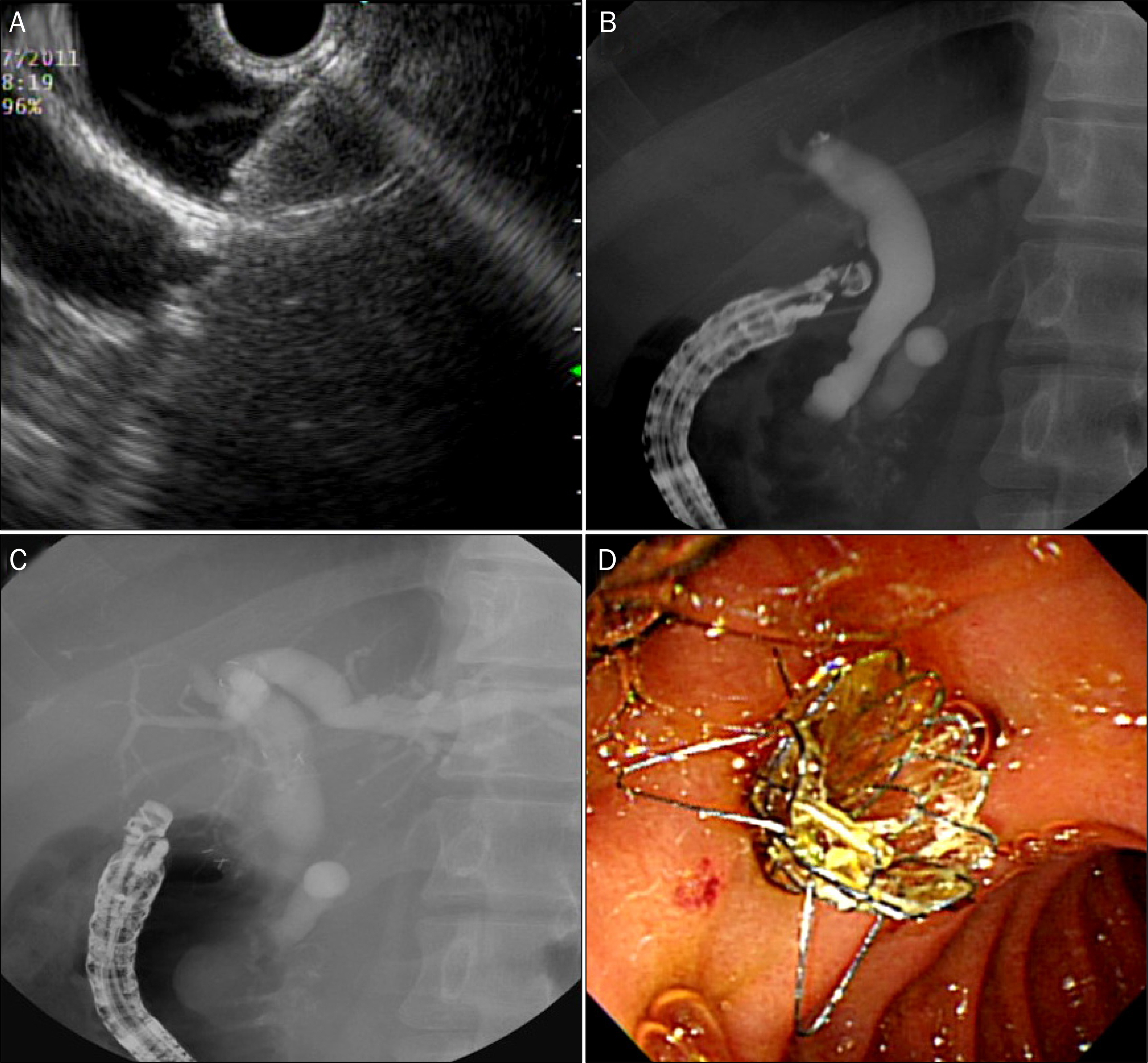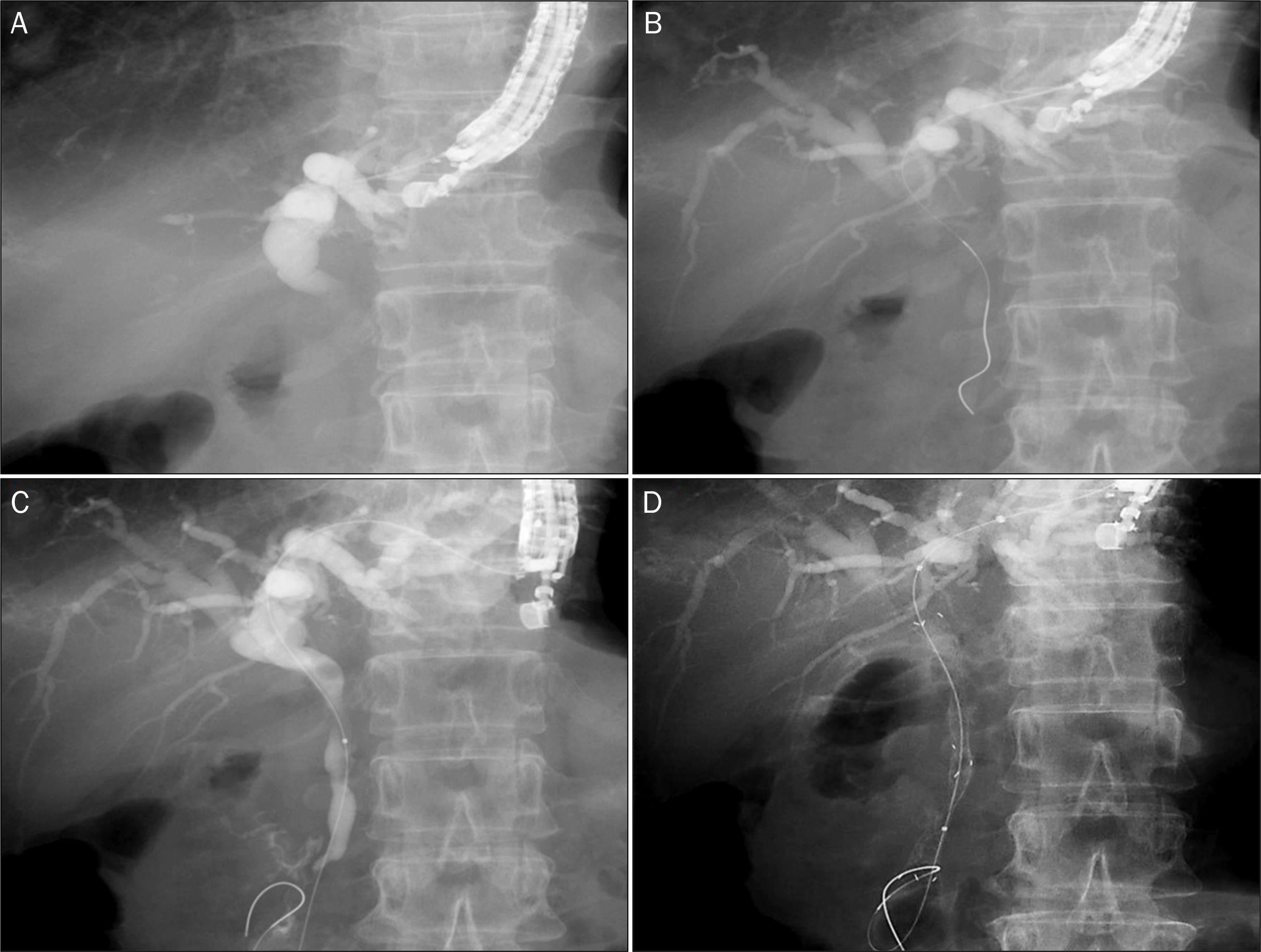Korean J Gastroenterol.
2017 Mar;69(3):164-171. 10.4166/kjg.2017.69.3.164.
Endoscopic Ultrasound-guided Biliary Drainage
- Affiliations
-
- 1Department of Internal Medicine, Pusan National University School of Medicine, Busan, Korea. sulsulpul@naver.com
- 2Research Institute for Convergence of Biomedical Science and Technology, Pusan National University Yangsan Hospital, Yangsan, Korea.
- KMID: 2383409
- DOI: http://doi.org/10.4166/kjg.2017.69.3.164
Abstract
- The therapeutic role of endoscopic ultrasound (EUS) has continued to evolve in recent years. EUS-guided biliary drainage (EUS-BD) can be performed as an effective alternative to percutaneous drainage or surgical options when conventional Endoscopic retrograde cholangiopancreatography fails or is not possible. Depending on the access and exit routes of the stent, multiple approaches to EUS-BD have been proposed. Each patient should receive an individualized approach based on the patient's condition, anatomy, and endoscopist's experience, with an appropriate backup prepared. In high-volume centers, the cumulative success rate has been reported to be over 90%. However, the reported overall complication rate remains relatively high at 10-30%. Further studies are necessary to better understand the long-term results and standardize EUS-BD, including appropriate indications and optimal approach.
Keyword
MeSH Terms
Figure
Cited by 1 articles
-
Comparison of the Diagnostic Performances of Same-session Endoscopic Ultrasound- and Endoscopic Retrograde Cholangiopancreatography-guided Tissue Sampling for Suspected Biliary Strictures at Different Primary Tumor Sites
Seong Jae Yeo, Chang Min Cho, Min Kyu Jung, An Na Seo, Han Ik Bae
Korean J Gastroenterol. 2019;73(4):213-218. doi: 10.4166/kjg.2019.73.4.213.
Reference
-
References
1. Kedia P, Gaidhane M, Kahaleh M. Endoscopic guided biliary drainage: how can we achieve efficient biliary drainage? Clin Endosc. 2013; 46:543–551.
Article2. Perez-Miranda M, de la Serna C, Diez-Redondo P, Vila JJ. Endosonography-guided cholangiopancreatography as a salvage drainage procedure for obstructed biliary and pancreatic ducts. World J Gastrointest Endosc. 2010; 2:212–222.
Article3. Weilert F, Binmoeller KF. Endoscopic ultrasound-assisted pancreaticobiliary access. Gastrointest Endosc Clin N Am. 2015; 25:805–826.
Article4. Nennstiel S, Weber A, Frick G, et al. Drainage-related complications in percutaneous transhepatic biliary drainage: an analysis over 10 years. J Clin Gastroenterol. 2015; 49:764–770.5. Crosara Teixeira M, Mak MP, Marques DF, et al. Percutaneous transhepatic biliary drainage in patients with advanced solid malignancies: prognostic factors and clinical outcomes. J Gastrointest Cancer. 2013; 44:398‐403.
Article6. van Delden OM, Laméris JS. Percutaneous drainage and stenting for palliation of malignant bile duct obstruction. Eur Radiol. 2008; 18:448‐456.
Article7. Wiersema MJ, Sandusky D, Carr R, Wiersema LM, Erdel WC, Frederick PK. Endosonography-guided cholangiopancreatography. Gastrointest Endosc. 1996; 43(2 Pt 1):102–106.
Article8. Giovannini M, Moutardier V, Pesenti C, Bories E, Lelong B, Delpero JR. Endoscopic ultrasound-guided bilioduodenal anastomosis: a new technique for biliary drainage. Endoscopy. 2001; 33:898–900.
Article9. Mallery S, Matlock J, Freeman ML. EUS-guided rendezvous drainage of obstructed biliary and pancreatic ducts: report of 6 cases. Gastrointest Endosc. 2004; 59:100–107.
Article10. Kahaleh M, Artifon EL, Perez-Miranda M, et al. Endoscopic ultrasonography guided drainage: summary of consortium meeting, May 21, 2012, San Diego, California. World J Gastroenterol. 2015; 21:726–741.
Article11. Itoi T, Yamao K. EUS 2008 Working Group. EUS 2008 working group document: evaluation of EUS-guided choledochoduodenostomy (with video). Gastrointest Endosc. 2009; 69(2 Suppl):S8–S12.
Article12. Savides TJ, Varadarajulu S, Palazzo L. EUS 2008 Working Group. EUS 2008 working group document: evaluation of EUS-guided hepaticogastrostomy. Gastrointest Endosc. 2009; 69(2 Suppl):S3–S7.
Article13. Artifon EL, Safatle-Ribeiro AV, Ferreira FC, et al. EUS-guided antegrade transhepatic placement of a self-expandable metal stent in hepatico-jejunal anastomosis. JOP. 2011; 12:610–613.14. Nguyen-Tang T, Binmoeller KF, Sanchez-Yague A, Shah JN. Endoscopic ultrasound (EUS)-guided transhepatic anterograde self-expandable metal stent (SEMS) placement across malignant biliary obstruction. Endoscopy. 2010; 42:232–236.
Article15. Almandi MA, Pausawasdi N, Ratanchuek T, Teoh AY B, Ho KY, Dhir V. Endoscopic ultrasound-guided biliary drainage. Gastrointest Interv. 2016; 5:203–211.16. Iwashita T, Doi S, Yasuda I. Endoscopic ultrasound-guided biliary drainage: a review. Clin J Gastroenterol. 2014; 7:94–102.
Article17. Dhir V, Isayama H, Itoi T, et al. EUS-guided biliary and pancreatic duct interventions. Dig Endosc. 2017 Jan 24. [Epub ahead of print].18. Khashab MA, Levy MJ, Itoi T, Artifon EL. EUS-guided biliary drainage. Gastrointest Endosc. 2015; 82:993–1001.
Article19. Perez-Miranda M, De la Serna Higuera C, Gil-Simon P, Hernandez V, Diez-Redondo P, Fernandez-Salazar L. EUS guided choledochoduodenostomy with lumen-apposing metal stent after failed rendezvous in synchronous malignant biliary and gastric outlet obstruction (with video). Gastrointest Endosc. 2014; 80:342. discussion 343–344.20. Khashab MA, Valeshabad AK, Modayil R, et al. EUS-guided biliary drainage by using a standardized approach for malignant biliary obstruction: rendezvous versus direct transluminal techniques (with videos). Gastrointest Endosc. 2013; 78:734–741.
Article21. Park DH, Jeong SU, Lee BU, et al. Prospective evaluation of a treatment algorithm with enhanced guidewire manipulation protocol for EUS-guided biliary drainage after failed ERCP (with video). Gastrointest Endosc. 2013; 78:91–101.
Article22. Hara K, Yamao K, Mizuno N, et al. Endoscopic ultrasonography-guided biliary drainage: who, when, which, and how? World J Gastroenterol. 2016; 22:1297–1303.
Article23. Khashab MA, Dewitt J. EUS-guided biliary drainage: is it ready for prime time? Yes! Gastrointest Endosc. 2013; 78:102–105.24. Wang K, Zhu J, Xing L, Wang Y, Jin Z, Li Z. Assessment of efficacy and safety of EUS-guided biliary drainage: a systematic review. Gastrointest Endosc. 2016; 83:1218–1227.25. Tyberg A, Desai AP, Kumta NA, et al. EUS-guided biliary drainage after failed ERCP: a novel algorithm individualized based on patient anatomy. Gatrointest Endosc. 2016; 84:941–946.
Article26. Dhir V, Itoi T, Khashab MA, et al. Multicenter comparative evaluation of endoscopic placement of expandable metal stents for malignant distal common bile duct obstruction by ERCP or EUS-guided approach. Gastrointest Endosc. 2015; 81:913–923.
Article27. Kunda R, Pérez-Miranda M, Will U, et al. EUS-guided choledochoduodenostomy for malignant distal biliary obstruction using a lumen-apposing fully covered metal stent after failed ERCP. Surg Endosc. 2016; 30:5002–5008.
Article28. Maranki J, Hernandez AJ, Arslan B, et al. Interventional endoscopic ultrasound-guided cholangiography: long-term experience of an emerging alternative to percutaneous transhepatic cholangiography. Endoscopy. 2009; 41:532–538.
Article29. Kim YS, Gupta K, Mallery S, Li R, Kinney T, Freeman ML. Endoscopic ultrasound rendezvous for bile duct access using a transduodenal approach: cumulative experience at a single center. A case series. Endoscopy. 2010; 42:496–502.
Article30. Shah JN, Marson F, Weilert F, et al. Single-operator, single-session EUS-guided anterograde cholangiopancreatography in failed ERCP or inaccessible papilla. Gastrointest Endosc. 2012; 75:56–64.
Article31. Iwashita T, Lee JG, Shinoura S, et al. Endoscopic ultrasound-guided rendezvous for biliary access after failed cannulation. Endoscopy. 2012; 44:60–65.
Article32. Dhir V, Bhandari S, Bapat M, Maydeo A. Comparison of EUS guided rendezvous and precut papillotomy techniques for biliary access (with videos). Gastrointest Endosc. 2012; 75:354–359.33. Lee TH, Choi JH, Park do H, et al. Similar efficacies of endoscopic ultrasound-guided transmural and percutaneous drainage for malignant distal biliary obstruction. Clin Gastroenterol Hepatol. 2016; 14:1011–1019.e3.
Article34. Artifon EL, Aparicio D, Paione JB, et al. Biliary drainage in patients with unresectable, malignant obstruction where ERCP fails: endoscopic untrasonography-guided choledochoduodenostomy versus percutaneous drainage. J Clin Gastroenterol. 2012; 46:768–774.35. Poincloux L, Rouquette O, Buc E, et al. Endoscopic ultrasound-guided biliary drainage after failed ERCP: cumulative experience of 101 procedures at a single center. Endoscopy. 2015; 47:794–801.
Article
- Full Text Links
- Actions
-
Cited
- CITED
-
- Close
- Share
- Similar articles
-
- Recent development of endoscopic ultrasound-guided biliary drainage
- Endoscopic ultrasound-guided biliary drainage in malignant distal biliary obstruction
- Endoscopic Ultrasound-Guided Hepaticogastrostomy: Technical Review and Tips to Prevent Adverse Events
- Endoscopic Ultrasound-Guided Biliary Drainage for Unresectable Hilar Malignant Biliary Obstruction
- Advances in Endoscopic Ultrasound-Guided Biliary Drainage: A Comprehensive Review





